To heat or not, predator protection, managing molting, and other alliterative ways to prep your poultry for winter from Elizabeth Mack.
Winter is here—if an arctic blast hasn’t surprised you already! While chickens are quite hardy, they do need some special cold-weather management, depending on your location and breed of chicken. Taking a few steps to prepare your flock now for the coming season will ensure they’re safe and snug for winter.
Managing Molting

My Rhode Island Red and Barred Rock are molting in early November, with temperatures well below freezing. All photos by author.
Once chickens are 16 to 18 months of age, they’ll experience a molt, losing their feathers in late summer or fall. The changing daylight hours and falling temperatures trigger a molt. However, it’s not uncommon to have chickens molt late, leaving them with little feather insulation to keep their bodies warm.
Typically, a molt lasts around 6 to 8 weeks, but it can take up to 16 weeks for chickens to grow back their feathers. During this time, increase their protein consumption. Regular layer feed is higher in calcium for egg shell production, but since feathers are 80 percent protein, a diet of 20 percent protein will help to encourage feather regrowth. As soon as you notice feathers flying, slowly introduce the higher protein mix into their regular feed to get their digestive track used to the new diet. As they come out of molt and begin laying, slowly cut back the higher protein rations to their regular layer feed.
Windbreaks
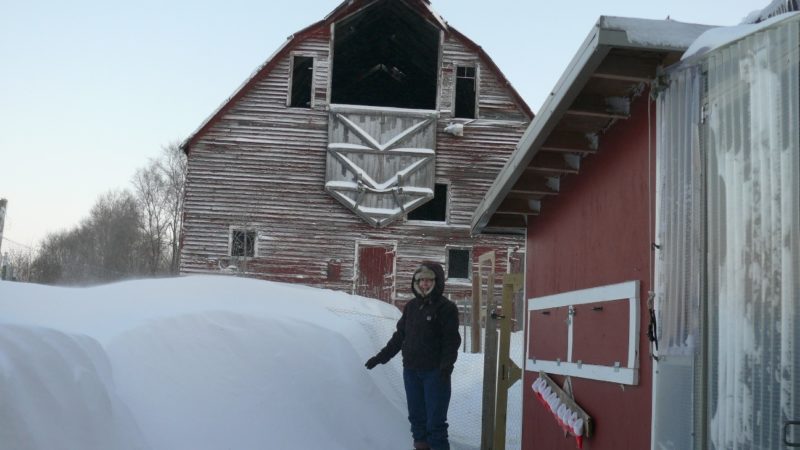
A bit of luck and a perfectly placed snow fence keeps snow drifts away from the coop.
With a full coat of shiny new feathers, chickens can tolerate cold temperatures, but they hate the wind. Before the cold weather hits, set up windbreaks in the open run or pen with straw bales by placing them against any north or west exposures. For an extra layer of insulation, place straw bales around the outside perimeter of the coop floor to keep the winds at bay. I’ve also built a mini chicken house that I keep inside the run. When the winter winds whip through the run, the chickens snuggle up in the smaller hut.

This small hut lets birds get outside but keeps them protected from wind.
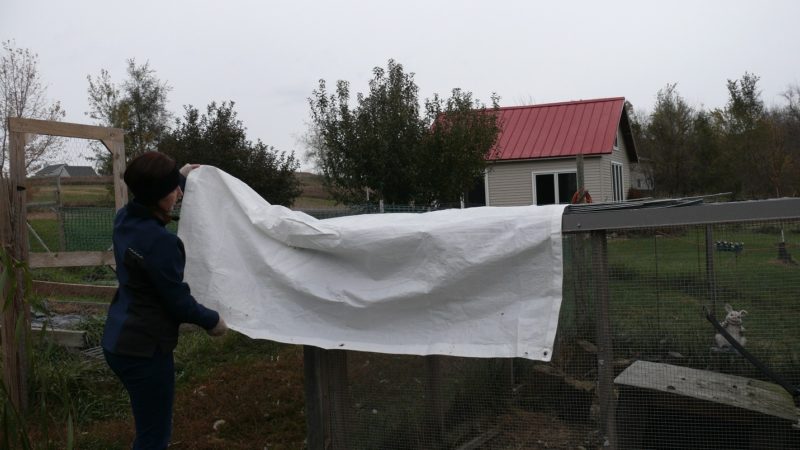
A white tarp keeps out snow and rain but allows light in.
Since our run is exposed to the north and west, we wrap it on each of those sides, keeping the eastern side exposed for morning sun. I use white tarps on the large run, which allows some light to shine through.
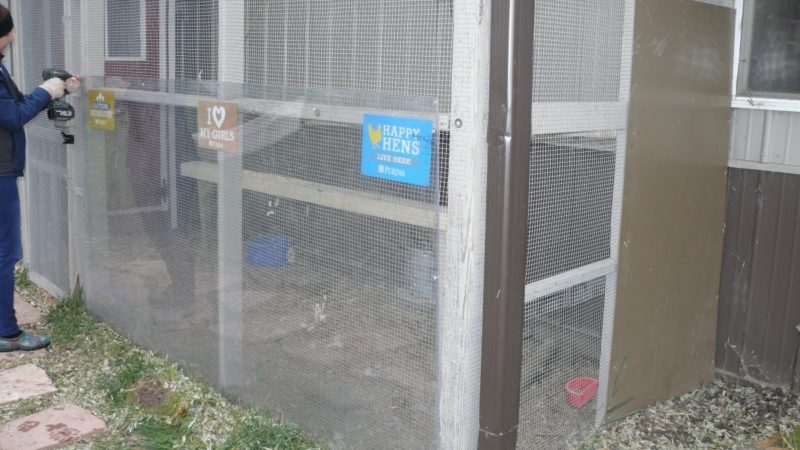
Hang 4-by-8-foot poly sheeting by pre-drilling holes, and then screwing it into the wood.
On the entrance door and smaller front pen, we hang sheets of clear polycarbonate panels, which allow me to see in, and allow the chickens to see out from their favorite perch. If you get a lot of snow, you might want to cover part of the top, but be careful of snow load or heavy ice. After our last harsh winter, we found that the weight of the snow almost collapsed the roof over the predator-proof run.
Inside the Coop
During winter, your chickens spend more time inside their coop, so keeping it insulated—but well ventilated—is essential. On the coop floor, you can incorporate the deep litter method. To do so, lay a 4- to 5-inch thick layer of pine shavings or other absorbent material on the floor. Turn it over every week or two, adding fresh shavings when needed. The chickens will do the rest by scratching and turning it over. This litter method doubles as a great floor insulation. Once winter is over, do a thorough coop cleaning and start over. I utilize this method year-round and have never experienced any odors from accumulated droppings.
While it’s smart to insulate the coop in cold climates, it’s essential to incorporate ventilation at the roofline. If the air can’t escape, moisture will develop inside the coop. This can be disastrous for your chickens, causing serious respiratory problems, as well as frostbite. Check to make sure the ventilation openings are free from obstructions, such as bird nests.
As the temperatures dip, your chickens will roost with their feet tucked under their warm bodies to avoid frostbite. To do this, they need a roost wide enough to lay their feet flat. For most breeds, a 2-by-4-foot piece of wood works well as a roost Avoid metal for roosts, which not only retains cold temperatures, but can also become moist and freeze.
To Heat or Not to Heat
Once your chickens have regrown their feathers, they’ll have natural insulation for the coming winter. However, many chicken owners living in sub-zero climates struggle with the decision of whether or not to add supplemental heat. Heating a coop is a hotly debated topic, so it’s essential to weigh all the facts and make the best decision according to your climate and your specific flock.
A small flock in a large coop is going to struggle much harder to keep warm than a flock in an adequately sized coop. If you’ve done your homework and offer about 3 to 4 square feet per bird in your coop, the body heat they generate will keep them comfortable on most days.
Where I live on the open plains of Nebraska, it’s not unusual to have a stretch of days with wind chills reaching -40 degrees. Winter winds can blow up to 60 mph on my property. On these nights, I heat my well-ventilated coop with a small space heater that is cool to the touch. I set it off the floor and plug it into an outlet at the roofline, where it’s less likely to spark from dust buildup or pine shavings. Never heat the coop unless you’re home to check on your birds; one winter, a neighbor lost her entire flock from heating the coop with a hot lamp.
Chickens can tolerate the cold much better than the heat, and overheating a flock can negatively affect their ability to acclimate to extreme weather. Even though you might think it’s freezing when it’s 32 degrees, your chickens will be just fine.
Predator Proofing
As the temperatures fall, agricultural fields are harvested, and food sources become more scarce, natural predators—most notably raccoons and coyotes—will come sniffing around your flock. Take precautions to make sure the coop and run are secure. Inspect the run, checking that the hardware cloth is securely fastened, with no visible breeches around the bottom. Staples used to install hardware cloth come loose over time, so check and repair any loose fencing often. Also check at the roofline. If you let your chickens free range, provide a covered area to hide from hungry overhead predators.

Hungry turkey vultures often eye my flock from the top of my silo.
Food and Water Management
The best way to avoid predators is to keep your feed inside a secure garage or building. Keep feed covered in a weatherproof container with a tight lid. I also recommend keeping scratch grains on hand for a nightly treat; digesting the scratch when chickens go to roost helps generate energy that raises their body temperature. I also treat my hens to hot oatmeal for breakfast on colder mornings.
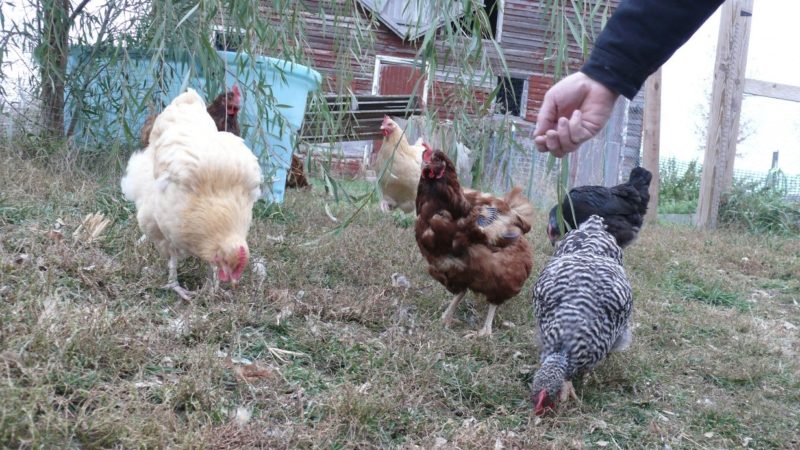
A treat of scratch grains before bedtime helps warm body temperatures.
Avoiding frozen water can be a struggle. Invest in heated dog bowls, and place them outside the coop. Even on the coldest days, you want your chickens to exercise outside, so placing the bowls outside will motivate them to move. Even during winter, avoid keeping your chickens locked up during the day. My Rhode Island Reds, Orpingtons, and Australorps actually like to go outside on frigid days, as long as they’re out of the wind.
If there’s snow on the ground, you’ll want to lay some straw down, as chickens generally don’t like to walk on the ice or snow. Keep petroleum jelly on hand to protect exposed combs and wattles on the coldest nights.
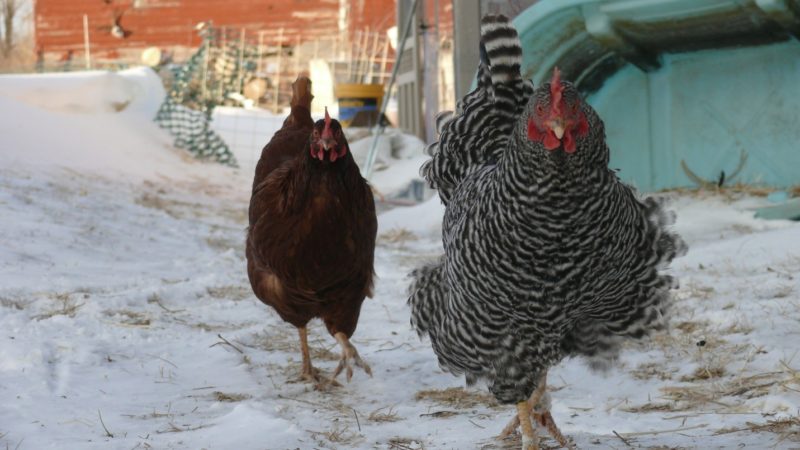
Mamie and Willa on a winter stroll.
Careful preparation ahead of time will keep your chickens happy and healthy through anything winter can throw at you.
Freelance writer Elizabeth Mack keeps a small flock of chickens on a 2-plus acre hobby farm outside of Omaha, Nebraska. Her work has appeared in Capper’s Farmer, Out Here, First for Women, Nebraskaland, and numerous other print and online publications. Her first book, Healing Springs & Other Stories, includes her introduction – and subsequent love affair – with chicken keeping. Visit her website at Big Mack Writing.













1 Comment
I really enjoyed reading about Winter & Chickens And keeping them healthy And happy during the cold winner.